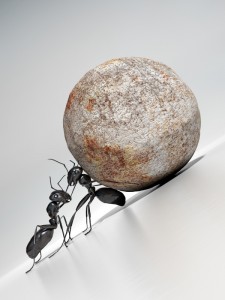 Sustainable purchasing is a big rock. But we’ve moved it a good distance in a short time. In fact, some of the world’s largest buyers have made big commitments to sustainable purchasing practices. But just as our progress on sustainable supply chains has accelerated, so has the urgency to rethink how we use our corporate purchasing power – and how we can revamp the way we manufacture, produce, package, transport, buy and consume.
Sustainable purchasing is a big rock. But we’ve moved it a good distance in a short time. In fact, some of the world’s largest buyers have made big commitments to sustainable purchasing practices. But just as our progress on sustainable supply chains has accelerated, so has the urgency to rethink how we use our corporate purchasing power – and how we can revamp the way we manufacture, produce, package, transport, buy and consume.
I think we should keep pushing this rock up the hill. And I believe that in order to spread the practices widely, we need to develop replicable, scalable, impactful, timely models. What do you think? Please share your ideas, insights and innovations.
Here are my observations.
Big Players Significant Commitments
Olympics
In 2006 I worked with the sustainability team of the Vancouver 2010 Olympic and Paralympic Winter Games to develop a sustainable purchasing policy. Back then it was tough to get buy-in. But we persevered and broke ground with VANOC’s BuySmart program. Now London 2012 is guided by a Sustainable Sourcing Code whose vision is
“Suppliers and licensees will ensure that products and services are sourced and produced under a set of internationally acceptable environmental, social and ethical guidelines and standards.”
Walmart
Other big players have made significant commitments too. Walmart, the world’s largest company with 100,000 suppliers, aims to eliminate 20 million metric tons of GHG emissions from its supply chain by the end of 2015, mostly through collaboration with suppliers.
In 2009, Walmart provided the initial funding for The Sustainability Consortium (TSC), a membership-based organization that aims to develop a database of information about the environmental footprint of the entire lifecycle of every product sold through Walmart and other retailers. It is administered jointly by the Arizona State University and the University of Arkansas. They have prioritized 50 product categories for their work including:
- Home and personal care
- Food and beverage
- Electronics
- Paper
Last month, Walmart announced that it will integrate the sustainability assessments of key product categories conducted by TSC into its supplier sustainability scorecard, some of which include beef, milk, plastic toys, computers, laundry detergent, televisions, toilet tissue, packaged cereal, copy paper, bread, surface cleaners, showering products, farmed salmon, printers, beer and wine with more to come by the end of the year. Check out this short video.
United States Government
The public sector is also greening its supply chains. A notable player is the U.S. Government, the world’s largest buyer of goods and services with approximately 230,000 suppliers. It purchases over $500 billion in products and services each year.
The General Services Administration (GSA) is the U.S. Government’s procurement agency. It acquires, on behalf of federal agencies, office space, equipment, telecommunications, information technology, supplies and services. It procures about $66 billion in annual goods and services.
More than two years ago the Obama administration passed Executive Order 13514: “Federal Leadership in Environmental, Energy, and Economic Performance” which stipulates that:
“Federal agencies […] shall leverage agency acquisitions to foster markets for sustainable technologies and environmentally preferable materials, products, and services.”
To implement this order the GSA adopted a 2011 – 2016 Strategic Sustainability Performance Plan which includes Goal 6, Sustainable Acquisition that states:
GSA will ensure that at least 95 percent of new contract actions in support of GSA operations and using GSA funds require the supply or use of environmentally preferable products and services, including those that are energy efficient, water efficient, bio-based, non-ozone depleting, contain recycled content, or are non-toxic or less toxic alternatives.
As large retailers and institutional buyers convert to green sourcing, this will have a significant ripple effect in the economy and among their suppliers who will in turn cascade these green and socially responsible demands in their supply chain.
Growing Global Middle Class Taps Natural Resources
The global middle class is predicted to grow by 3 billion in under 20 years, according to a 2010 OECD study. As markets grow, so does the strain on natural resources. A key driver of sustainable supply chains is access to resources. Forward-thinking organizations anticipate future demand for increasingly scarce resources including agricultural commodities, fresh water, timber, minerals, etc. They invest in their supplier communities to secure their supplies and improve the sustainability practices of their suppliers.
Critical Success Factors
To support continuous improvement in sustainable purchasing – and to keep that rock moving – I have developed a list of critical success factors. I’d like your input. What would you add or subtract from this list? By sharing our experiences we can accelerate the proliferation of sustainable supply chains.


